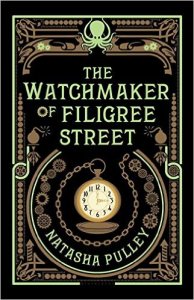Faren Miller reviews Natasha Pulley
The Watchmaker of Filigree Street, Natasha Pulley (Bloomsbury 978-1-62040-833-9, $26.00, 322pp, hc) July 2015.
 The Watchmaker of Filigree Street is a remarkably assured first novel that makes the most of Natasha Pulley’s varied influences, from studies in English lit. and creative writing to her current life in Tokyo. Though there’s plenty of dust in her Victorian London by the end of Chapter Three, it’s debris from bombs detonated by Irish rebels (who manage to destroy Scotland Yard and exile the Home Office to new quarters in a basement), rather than the fustiness of olden times. Much of this city is already moving forward, without a need for steampunk’s elaborate retro-futurism to lead the way, but it’s vast enough to move at many paces: from wagon wheels jolting against cobblestone to express trains packed with hordes of commuters.
The Watchmaker of Filigree Street is a remarkably assured first novel that makes the most of Natasha Pulley’s varied influences, from studies in English lit. and creative writing to her current life in Tokyo. Though there’s plenty of dust in her Victorian London by the end of Chapter Three, it’s debris from bombs detonated by Irish rebels (who manage to destroy Scotland Yard and exile the Home Office to new quarters in a basement), rather than the fustiness of olden times. Much of this city is already moving forward, without a need for steampunk’s elaborate retro-futurism to lead the way, but it’s vast enough to move at many paces: from wagon wheels jolting against cobblestone to express trains packed with hordes of commuters.
In November 1883, Nathaniel Steepleton is one of many telegraph operators at the Home Office. His own home’s a grungy flat just like those of his neighbors, ‘‘all members of the crowd of black coats and black hats that swamped London for half an hour every morning and evening.’’ The first of this book’s multiple mysteries is a break-in where nothing’s taken but someone has washed his dishes and left behind a velvet box containing a pocket watch ‘‘made of a rosy gold he hadn’t seen before’’ and superbly crafted (‘‘The chain slithered gently after it, the links all smoothed flawless, without the slightest hairline space or ripple of solder to show where they had been joined’’). Though it feels warm enough to be alive, the thing won’t truly function until the following May, when the bombs go off.
Explosions can be triggered by mechanical devices much like the workings of a pocket watch. A combination of personal curiosity and his bosses’ new suspicion of any advance in time-keeping leads Nathaniel to take a short trip by Underground to find the watchmaker: K. Mori, 27 Filigree Street, Knightsbridge. It’s an obscure byway, ‘‘a medieval row of houses whose upper stories leaned toward each other,’’ but at ground level (where the shops are) one place stands out: ‘‘In the window, a single lamp illuminated a clockwork model of a city that grew new towers and bridges until it became London.’’
When he enters through an unlocked door, electric lights hum on – startling him. He sees a sign beside the door: Room to let. He’ll end up taking it, hoping to learn more about the frumpy Japanese man with dyed blond hair who crafted this:
Across the wall beside him was a tall pendulum clock, its movement regulated by the jointed wings of a golden locust. A mechanical model of the solar system spun in midair, floating on magnets, and up two steps in the tiered floor, little bronze birds sat perched on the edge of the desk. One of them hopped onto the microscope and tapped its beak hopefully on the brass fittings. Things glimmered and clicked everywhere.
By now, we’ve also encountered Grace, a woman with her own Mori watch. At Oxford, this ugly-duckling spinster is an apprentice scholar, specializing in highly technical investigation into a field as speculative as dark matter in modern astronomy. First proposed by ancients but potentially linked to the workings of the human mind, it’s ether (AKA aether).
Other plot threads involve Japanese politics – conspiracy, diplomacy and modernization amidst castles and samurai; a form of weather manipulation that can resemble alchemy; Grace’s maddening relationship with her family; plus further mysteries that won’t be solved by feats of Holmesian brilliance. Somehow, Natasha Pulley turns this wild mix into a tale as elegant as one of the master watchmaker’s creations, for a debut that’s fast-paced, suspenseful, and curiously convincing. Near the dawn of the 20th century, both the mythic past and the far future feel within reach – close enough to touch.




